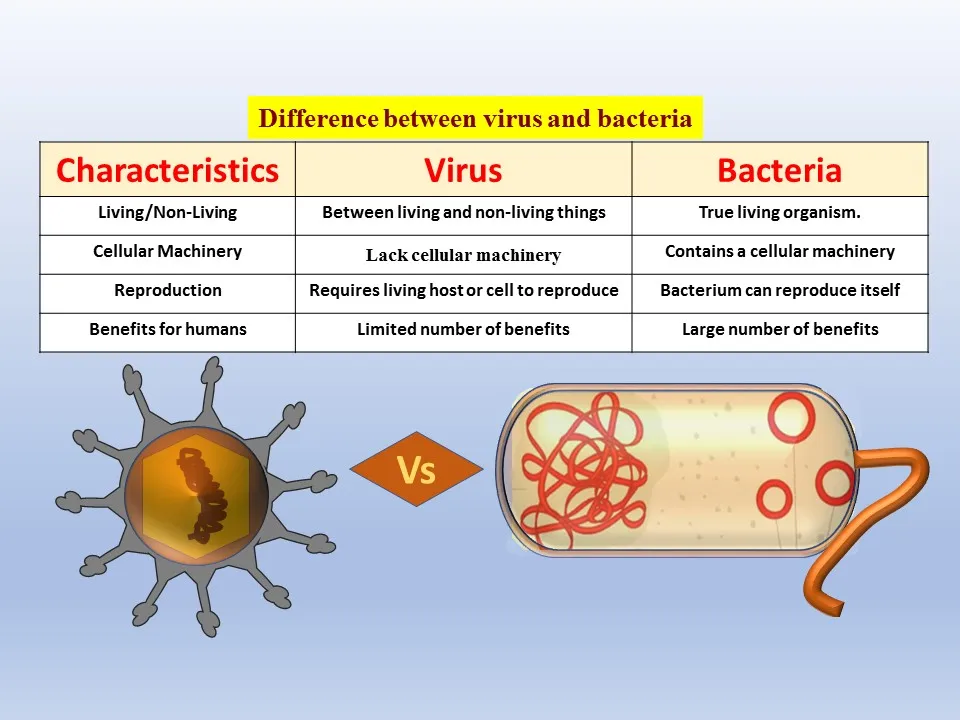Understanding the differences between viruses and bacteria is vital for several reasons. Firstly, it helps us grasp how these tiny organisms affect our health. Viruses, like the flu, need a host to survive and multiply, while bacteria, such as E. coli, can often live independently. This basic knowledge is key in medicine, guiding doctors in choosing the right treatment. For example, antibiotics work against bacteria but not viruses.
In biology, this understanding is equally important. It sheds light on how these organisms evolve and interact with their environment. This insight is crucial for developing new treatments and preventive measures.
Knowing the differences also empowers us with everyday health decisions, like when to use hand sanitizer or seek medical advice. In simple terms, this knowledge keeps us one step ahead in maintaining our health and well-being.
Basic Definitions of viruses and bacteria
What are Viruses? Viruses are tiny invaders that can’t live on their own. Imagine them as hijackers. They enter living cells and use them to multiply. They’re so small, you need a microscope to see them. Viruses cause illnesses like the common cold and more serious ones like COVID-19. They’re not alive in the way plants and animals are. They only “wake up” and multiply inside a living host.
Characteristics of Viruses:
- Super small, need a microscope to see.
- Can’t survive without a living host.
- Cause a range of illnesses.
- Have genetic material, either DNA or RNA, wrapped in a protein coat.
What are Bacteria? Bacteria are tiny, single-celled organisms. They’re everywhere – in soil, water, and even in our bodies. Some bacteria are good for us, like those in our gut that help digest food. Others can make us sick, like the ones causing strep throat. Unlike viruses, bacteria can live on their own. They’re diverse, adaptable, and some can even make their own food through photosynthesis.
Characteristics of Bacteria:
- Tiny, single-celled organisms.
- Can live independently, unlike viruses.
- Found almost everywhere.
- Some are helpful, some can cause diseases.
- Can reproduce on their own.
Structural Differences between Viruses and Bacteria
Size and Shape: A World of Difference
Viruses are incredibly tiny, much smaller than bacteria. Picture them as minuscule dots, invisible to the naked eye and only visible under powerful microscopes. Bacteria, though still small, are larger and can be seen with standard laboratory microscopes. When it comes to shape, viruses are often geometric, resembling tiny balls or rods. Bacteria, in contrast, display a variety of shapes – some are spherical, others rod-shaped, and some even twist like corkscrews.
Genetic Material: The Blueprint of Life
Viruses have a simple structure. They carry their genetic code, either DNA or RNA, inside a protein coat. This is like a tiny, essential package of instructions. However, viruses lack the internal machinery to function independently. They need to invade a host’s cells to replicate and thrive.
Bacteria are more complex and self-reliant. Their DNA is usually in a single, circular strand, floating freely within the cell. Bacteria are like tiny, self-contained factories. They have all the necessary components to live and reproduce autonomously. They can synthesize their own proteins, replicate their DNA, and some even have the ability to move on their own.

Cellular Structure: The Building Blocks
Bacteria are true cells with a well-defined cellular structure. They have a cell wall and membrane, and many have flagella or pili that help them move or attach to surfaces. Inside, they house all the machinery needed for life – from DNA replication to energy production.
Viruses, on the other hand, are not considered true cells. They lack many of the structures that bacteria have, like a cell wall or membrane-bound organelles. Their simplicity is what makes them dependent on other organisms for survival and reproduction.
Reproduction Methods of Viruses and Bacteria
Viruses: The Host-Dependent Hijackers
Viruses are unique in their reproduction method, as they cannot reproduce on their own. They need a host cell to replicate. Think of viruses as pirates that hijack a ship. Once they invade a host cell, they take over its machinery to produce more viruses. This process starts when a virus attaches itself to a host cell and injects its genetic material into it. The viral DNA or RNA then uses the host’s cellular components to replicate and assemble new virus particles. This is why viruses are often associated with diseases – they disrupt normal cell function, leading to illness.
The need for a host makes viruses highly adaptive and sometimes difficult to treat. They can mutate rapidly, which often leads to the emergence of new strains, making the development of effective treatments and vaccines a constant challenge.
Bacteria: The Independent Reproducers
Bacteria, in contrast, are capable of reproducing independently. They don’t need a host like viruses do. Most bacteria reproduce through a process called binary fission. This is a form of asexual reproduction where a single bacterial cell divides into two identical daughter cells. First, the bacterial DNA replicates, and the cell grows in size. Then, the cell splits in half, creating two new cells. Each of these cells is a clone of the original, carrying the same genetic material.
This ability to reproduce quickly and independently is why bacterial populations can grow rapidly under favorable conditions. However, it’s also why bacterial infections can spread and become problematic if not properly managed. Bacteria’s independent nature and rapid reproduction rate make them a significant concern in various environments, from healthcare settings to agriculture.
Impact on Human Health: Viruses vs. Bacteria
Viral Diseases: Invisible Invaders
Viruses are behind many well-known diseases. They can range from the common cold to more serious conditions like HIV/AIDS and COVID-19. When a virus enters your body, it can hijack your cells and multiply, leading to illness. For example, the flu virus targets your respiratory system, causing symptoms like coughing and a sore throat.
The impact of viral diseases can vary. Some, like the cold, are usually mild and go away on their own. Others, like HIV, can be life-threatening without proper treatment. Viruses can also be tricky to treat because they use your cells to replicate. This is why we often rely on vaccines to prevent viral diseases rather than treat them after infection.
Bacterial Infections: Tiny but Mighty
Bacteria can cause a wide range of infections, from minor skin irritations to severe illnesses like pneumonia or tuberculosis. Unlike viruses, some bacteria are beneficial and essential for our health, like those in our gut that help digest food. However, harmful bacteria can cause diseases when they invade our bodies.
Bacterial infections can often be treated with antibiotics. But, it’s important to use these drugs correctly. Misuse of antibiotics has led to the rise of “superbugs” – bacteria that are resistant to many antibiotics. This makes treating bacterial infections more challenging.
Both viruses and bacteria play significant roles in human health. While they can cause various diseases, understanding and respecting their nature is key to preventing and treating infections effectively. Remember, not all bacteria are bad, and not all viral infections are severe, but knowing the difference helps us stay healthier.
Treatment and Prevention of Viral and Bacterial Infections
Treating Viral Infections
When it comes to viruses, the treatment options are different from bacteria. Most viral infections don’t have a cure. Instead, treatments focus on relieving symptoms while your body fights off the virus. For example, if you have the flu, you might rest, drink fluids, and take medicine to reduce fever. In some cases, antiviral medications can help, especially if taken early. These drugs can lessen the severity and duration of certain viral infections.
Vaccines are a key part of preventing viral infections. They prepare your immune system to fight off viruses like the flu or measles. It’s important to stay up-to-date with vaccinations to protect yourself and others.
Treating Bacterial Infections
Bacterial infections are usually treated with antibiotics. These medicines kill bacteria or stop them from multiplying. It’s crucial to take antibiotics exactly as prescribed. Stopping early or misusing antibiotics can lead to antibiotic resistance, making bacteria harder to treat.
For some bacterial infections, there are also vaccines available. Like with viruses, these vaccines help your body build immunity to certain bacteria.
Preventative Measures for Viruses and Bacteria
Good hygiene is the first line of defense against both viruses and bacteria. This includes regular hand washing, especially before eating or after being in public places. Keeping surfaces clean and avoiding close contact with sick people can also help prevent the spread of infections.
For foodborne bacteria, safe cooking and food handling practices are important. This means cooking food to the right temperature and avoiding cross-contamination.
Evolutionary Perspectives: Viruses and Bacteria

How Viruses Have Evolved
Viruses are ancient and mysterious. They’ve been around for millions of years. Over time, they’ve become masters of change, adapting quickly to new environments. This ability to mutate fast lets them infect different hosts, from plants to humans. Think of viruses as shape-shifters, always changing to survive and spread.
How Bacteria Have Evolved
Bacteria are some of the oldest life forms on Earth. They’ve been here for billions of years. In this time, they’ve learned to live almost everywhere, from hot springs to the human gut. Bacteria change by swapping genes with each other. This sharing helps them adapt to new challenges, like antibiotics.
Their Roles in the Ecosystem
Viruses and bacteria are more than just germs that make us sick. They play big roles in nature. Viruses can control how many of certain creatures are in an area. This helps keep nature in balance. Bacteria are nature’s recyclers. They break down dead stuff, turning it back into nutrients.
Impact on Other Species
Both viruses and bacteria can change other living things. Sometimes, they can be harmful, causing diseases. But other times, they can be helpful. For example, bacteria in our stomachs help us digest food.
Recent Research and Developments in Viruses and Bacteria
Breakthroughs in Virus Research
Recently, scientists have made exciting discoveries about viruses. One major breakthrough is in understanding how viruses can jump from animals to humans. This research is crucial, especially after the COVID-19 pandemic. It helps us prepare for and possibly prevent future outbreaks.
Another development is in the treatment of viral infections. Researchers are working on new antiviral drugs that are more effective and have fewer side effects. This could be a game-changer in treating diseases like HIV and hepatitis.
Advances in Bacterial Studies
In the world of bacteria, there’s been significant progress too. Scientists have discovered new types of antibiotics that can fight bacteria resistant to current drugs. This is big news because antibiotic resistance is a growing problem worldwide.
Another exciting area is the use of bacteria in environmental protection. Researchers are exploring how bacteria can help clean up pollution and even combat climate change. This could lead to more sustainable ways to protect our planet.
Future Implications
These discoveries have big implications for the future. Understanding how viruses jump between species could help prevent new diseases. Better antiviral drugs could save millions of lives.
In the case of bacteria, new antibiotics could turn the tide against resistant infections. And using bacteria for environmental protection could help us tackle some of our biggest challenges, like pollution and climate change.
Conclusion:
Viruses and bacteria are different in many ways. Viruses are tiny, need a host to reproduce, and often cause diseases. Bacteria are larger, can live on their own, and are diverse – some are harmful, others beneficial. Knowing these differences is crucial in medicine and science. It helps us treat diseases better and understand how these tiny organisms affect our world. This knowledge is key to developing new treatments and keeping us healthy. In short, understanding viruses and bacteria helps us protect ourselves and the world around us.






